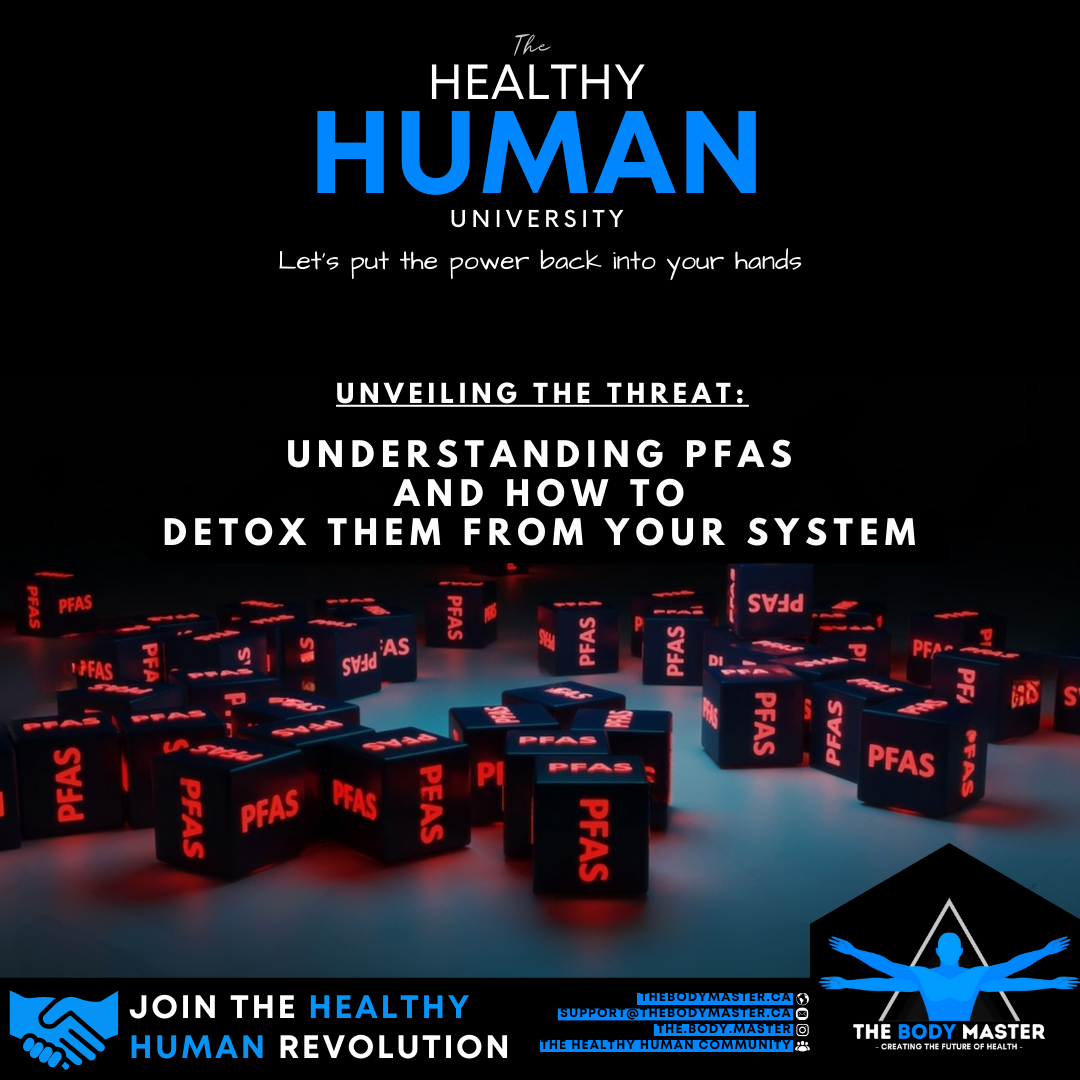Introduction:
In the realm of environmental pollutants, a group of substances known as PFAS, or per- and polyfluoroalkyl substances, has emerged as a pervasive and concerning threat. Aptly nicknamed "forever chemicals," PFAS possess remarkable durability, making them resistant to degradation over time. This persistence raises significant alarm, as PFAS can accumulate in the environment and, more worrisomely, in the human body. Understanding the dangers posed by PFAS and exploring effective detoxification methods is crucial in safeguarding our health and the planet.
As we delve into the depths of PFAS, it becomes evident that these substances are not merely a footnote in environmental discussions but rather a pressing issue that demands our attention. This article aims to unravel the mysteries surrounding PFAS, shedding light on their sources, the products through which most people are exposed, their adverse effects on the human body, and viable strategies for detoxification.
Join us on a journey through the hidden perils of forever chemicals, as we navigate the intricate web of PFAS contamination and empower ourselves with knowledge to mitigate their impact on our health and the environment.
What are PFAS?:
Per- and polyfluoroalkyl substances (PFAS) constitute a family of synthetic chemicals renowned for their water- and grease-resistant properties. This versatile quality has rendered them ubiquitous in countless everyday products, ranging from non-stick cookware and food packaging to stain-resistant carpets and firefighting foams. The distinctive feature of PFAS lies in their carbon-fluorine bonds, which impart exceptional stability, hence the moniker "forever chemicals."
The most studied PFAS compounds include perfluorooctanoic acid (PFOA) and perfluorooctane sulfonate (PFOS). However, the PFAS family encompasses thousands of related substances, each with its unique properties and potential health implications.
PFAS are not exclusive to industrial settings; they have infiltrated the environment and, consequently, the human body. From contaminated water sources to the air we breathe, PFAS have permeated various ecosystems, raising concerns about their long-term impact on both the environment and human health. As we explore the sources of PFAS exposure, it becomes evident that understanding and addressing this issue is paramount for the well-being of present and future generations.
Where are PFAS most commonly found?:
This list could fill over 14 pages of information so to illustrate how prominent these chemicals are in our daily lives, I'll express it with a photo:

However, I've found the most chronic exposure to be clothing, food packaging, and water.
Side effects of PFAS?:
As PFAS infiltrate our daily lives through various products, the concerning reality is that these forever chemicals can exert adverse effects on the human body. Extensive research has unveiled a range of health implications associated with PFAS exposure, raising alarms about their potential long-term consequences. Here are some key side effects linked to PFAS exposure:
1. Endocrine Disruption:
PFAS compounds have been shown to disrupt endocrine function, impacting the delicate balance of hormones in the body. This interference with the endocrine system can lead to reproductive issues, developmental abnormalities, and disruptions in metabolism.
2. Immune System Suppression:
Prolonged exposure to PFAS has been associated with suppression of the immune system. This weakened immune response can increase susceptibility to infections and hinder the body's ability to fight off diseases.
3. Liver Damage:
The liver is a primary target of PFAS toxicity. Studies have indicated that exposure to PFAS may result in liver damage and inflammation, potentially leading to more severe conditions such as liver disease and dysfunction.
4. Cancer Risk:
Certain PFAS compounds, particularly PFOA and PFOS, have been classified as potential carcinogens. Elevated levels of these substances in the body have been linked to an increased risk of certain cancers, including kidney and testicular cancers.
5. Thyroid Dysfunction:
PFAS exposure has been associated with disruptions in thyroid function, impacting the regulation of essential hormones. Thyroid dysfunction can contribute to a range of health issues, including weight gain, fatigue, and cognitive impairment.
6. Developmental Effects:
Fetuses, infants, and young children are particularly vulnerable to the developmental effects of PFAS. Studies suggest that exposure during pregnancy may lead to lower birth weights, delayed development, and other developmental abnormalities in children.
7. Cholesterol Imbalances:
PFOA and PFOS have been linked to disruptions in lipid metabolism, contributing to changes in cholesterol levels. Elevated cholesterol levels are a risk factor for cardiovascular diseases, emphasizing the potential cardiovascular impact of PFAS exposure.
Understanding these side effects reinforces the urgency of addressing PFAS contamination and minimizing exposure. As we become increasingly aware of the far-reaching consequences of forever chemicals, it becomes imperative to implement measures to mitigate their impact on human health and well-being.
How to detox PFAS?:
How to Detox PFAS from the Body: Exploring Strategies for Mitigation
The insidious infiltration of PFAS into our lives demands proactive measures to minimize the potential health risks associated with these persistent chemicals especially with our kids. While complete elimination of PFAS exposure may be challenging, adopting strategies to detoxify the body can contribute to mitigating their impact. Here, we explore effective methods, including the use of mushroom complexes and sauna therapy:
1. Mushroom Complexes:
Certain mushrooms, such as reishi, chaga, turkey tail, oyster, and maitake, have gained attention for their potential detoxification properties. These mushrooms contain bioactive compounds, including polysaccharides and antioxidants, which support the body's natural detoxification processes. Research suggests that these compounds may help bind to and eliminate PFAS from the body. Incorporating mushroom complexes into your diet or as supplements will assist in promoting overall detoxification, including and specifically PFAS. If you check the supplements section of the website, you will find a very potent all-natural mushroom complex from an FDA, NSF, and GMP approved lab. This is by far the strongest way to detox PFAS out of your body in addition to the next solution found below.
2. Sauna Therapy:
Sweating is a natural and effective way for the body to eliminate toxins, and sauna therapy provides an avenue for this process. Studies have indicated that sweating induced by sauna use can facilitate the excretion of PFAS through the skin. The heat from saunas stimulates circulation, promoting the release of toxins stored in fatty tissues. Regular sauna sessions, when done safely and with proper hydration, can be a valuable component of a holistic detoxification strategy. You can do this up to 3 times per week, making sure that you hydrate with minerals and shower off post-sauna. As a bonus, adding substances like zeolite to your pre-sauna water will help bind PFAS in the blood and will help excrete them from your system.
3. Hydration and Nutrition:
Staying well-hydrated with high-quality water is essential for supporting the body's natural detoxification mechanisms. Adequate water intake helps flush toxins from the body through urine. Additionally, adopting a nutritionally balanced diet rich in antioxidants, fiber, and nutrient-dense foods can enhance the body's resilience and support overall health, potentially aiding in the elimination of accumulated PFAS. The Healthy Human University has 2 day per each week detox protocol specifically designed for detoxing chemicals like this that build up in our fat cells and liver. This is done by consuming certain foods at certain times of the week to make sure the toxins don't recirculate or reposit back into the body.
4. Lifestyle Modifications:
Making conscious choices to reduce exposure to PFAS is a fundamental aspect of detoxification. This includes opting for PFAS-free cookware, choosing natural and organic products, and being mindful of the sources of potential contamination. Regular exercise can also play a role in promoting overall health and facilitating the elimination of toxins by activating your lymphatic system.
As we navigate the challenges posed by forever chemicals, embracing a multi-faceted approach to detoxification empowers individuals to take control of their health and reduce the burden of PFAS on the body. By combining knowledge, awareness, and proactive measures, we can work towards creating a healthier and safer environment for ourselves and future generations.
Conclusion:
The threat posed by PFAS, the "forever chemicals," is a significant concern that requires immediate attention. Understanding their sources, the products through which exposure occurs, and the potential adverse effects on the human body is crucial for safeguarding our well-being and the environment.
Detoxification strategies, such as incorporating mushroom complexes, sauna therapy, proper hydration, and lifestyle modifications, offer a proactive approach to mitigate the impact of PFAS. These methods not only assist in eliminating PFAS from the body but also contribute to overall health and well-being.
As we move forward, it is essential to stay informed, make conscious choices, and take proactive steps to reduce PFAS exposure. By doing so, we can collectively contribute to creating a healthier and safer future for ourselves and generations to come
In good health,
Michael
Founder of The Healthy Human University
Frequently Asked Questions (FAQs):
-
Q: Can PFAS be completely eliminated from the environment?
- A: Complete elimination of PFAS is challenging due to their persistent nature, but proactive measures can significantly reduce their impact.
-
Q: Are mushroom complexes safe for detoxifying PFAS?
- A: Yes, certain mushrooms with detoxification properties, such as reishi and chaga, are considered safe when used appropriately.
-
Q: How often should sauna therapy be performed for effective detoxification?
- A: Sauna therapy can be done up to 3 times per week, ensuring proper hydration and safety precautions.
-
Q: Does PFAS exposure only occur through industrial settings?
- A: No, PFAS have infiltrated various environments, including water sources, air, and everyday products like clothing and food packaging.
-
Q: What role does hydration play in PFAS detoxification?
- A: Adequate hydration supports the body's natural detoxification mechanisms, helping flush toxins, including PFAS, through urine.
















